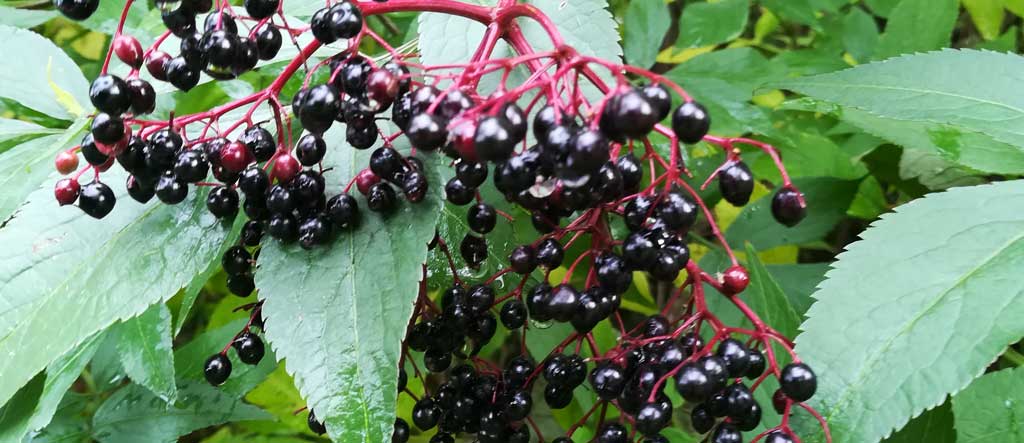Sambucus nigra

As summer comes to an end the hanging clusters of tiny elderberries change from green, to dark purple, to black when fully ripe. Each elderberry contains one to three seeds, which contain poisonous cyanogenic glycosides that can be deactivated by cooking. If you eat too many raw berries, which taste bitter-sweet, you will most likely feel nauseous.
Traditionally the berries were used in cough syrups, cordials and jams, or dried for use in teas and tinctures to strengthen immunity through the winter months. It is used to prevent and treat colds and flu, to treat eczema, and can even help to lower cholesterol.
The berries are rich in vitamin C and contain a wide range of flavonoids, including quercetin and anthocyanins, which are responsible for their health benefits.
Elderberry is a strong antiviral and has been shown to inhibit herpes virus and HIV in cell culture. Its anti-influenza ability is much researched in both Israel and Switzerland.²
Among all fruits, elderberries are the most concentrated source of anthocyanins, a class of flavonoids that act as powerful antioxidants to boost the immune system and protect the body’s cells from harm.¹
To Harvest Elderberry:
Pick bunches of elderberries on a dry day when ripe and black but still firm.
Use a fork to strip the berries from the stem.
Elderberry Syrup
Ingredients:
- 1 part fresh, ripe elderberries
- ½ part water
- 1 part raw honey
- Sterilised bottle or jar
OPTIONAL: Cinnamon stick, cloves, fresh or dried ginger
Vitamin C powder: ascorbic acid as preservative
Directions:
- De-stem the berries. The stems contain toxic compounds so make sure none remain.
- Place the berries and water in a saucepan and bring to a slow boil, then reduce heat to a simmer.
- Keep the berries at a low simmer and cook for about 30 minutes while stirring.
- Use a fine mesh sieve to strain the juice from the cooked elderberries into a glass container. Discard the pulp.
- Return the strained juice to the pot and add your spices, such as cloves, cinnamon, or dried or freshly grated ginger or lemon rind, and bring back to a boil.
- Simmer for a further 45 – 60 minutes or until liquid is reduced by about a half.
- Remove your syrup from the heat and allow to cool.
- When the juice has cooled down but is still a little warm, stir in the raw honey. Raw honey is antiviral and acts as a preservative to prevent your elderberry juice from spoiling quickly. To maintain its benefits, raw honey should not be heated above 110°F (43°C).
- Bottle and store in the fridge. For a longer shelf life add powdered Vitamin C (ascorbic acid.)
Dosage:
- 1 tsp every few hours for colds and flu. It is best taken in regular small doses.
- To build immunity take 1 tsp daily.
- IF STOOLS BECOME TOO LOOSE REDUCE THE DOSE.
- For a delicious hot drink add hot water to a tablespoon of syrup, add cloves and lemon.
NB: Honey should not be given to children under 1 year old – if making a syrup for infants use maple syrup instead of honey.
Related post: Elderflower
References:
(1) (2) Clinical Summary. Online article. Available at: http://www.blackelderberry.info/clinical-summary/ (Accessed 15/10/2018)
